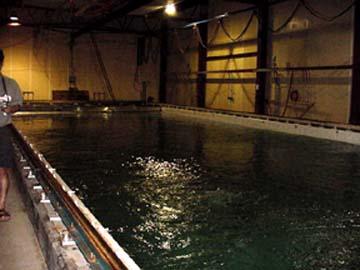7 August, 2002
THE EXPERIENCE BEGINS….
It’s day 2 of training for the new TEA parcticipants. Over the past two
days our brains have been flooded with information to help us prepare for our
TEA experience. We’ve been given overviews by past TEA parcticipants and
scientists that have combined information about polar research efforts with the
nitty gritty details of life on a research team in cold climates. We’ve also
gotten a chance to get to know our TEA colleagues, and discover what a multi-
talented group they are.
This afternoon has been spent covering the finer points of documenting daily
experiences through journal writing: format, content, and inclusion of
pictures. As the grand finale to this presentation, we lined up like
ducklings -- 6 penguin nestlings (TEAntarctica) and 6 eider ducklings
(TEArctic)—and took off behind Public Affairs Specialist Marie Darling for a
tour of CRREL, the Cold Regions Research and Engineering Lab. CRREL’s complex
is located in Hanover, NH and operates under the auspices of the Army Corps of
Engineers. This tour provided us with some concrete information for our first
journal activities and a chance to sample the big picture of polar engineering
research activities.
To set the stage for our discussion of cold climate research, we
entered the cold room, one of 24 walk-in coolers that are used to store samples
and field equipment. They are also used as venues for experiments needing cold
conditions. From our vantage point at –24F, the concept of polar climates
became just a little clearer. Sandals and shorts will not be part of the ECW
(extreme cold weather gear) kits that will be issued before heading to the
polar regions!
CRREL’s research projects are diverse. Many are conducted with
military or civil engineering applications in mind, but are equally applicable
to everyday life in cold climates. One such CRREL development is an antifreeze
additive for concrete that shortens curing time in low temperatures, whether
pouring airport runways in Bosnia or a driveway in Fairbanks. Environmental
remediation projects in polar regions have far-reaching applications in
environments that may not be so harsh. We might not all need to create tunnels
through hundreds of feet of ice, but scientists working at the South Pole do.
They are using CRREL-developed machinery to create tunnels for electric and
other utility lines. CRREL also maintains a reference library that is THE place
to look if you need information about things polar. If it’s about research in
cold places—it’s there!
To me, the best part of the visit was the Ice Engineering Research
Facility. This was the domain of wizards and inventors: devising tests,
creating scale models and monitoring systems, and answering those ‘what if’
questions we all need to ask. Picture a large indoor swimming pool tucked away
in a secluded part of the facility. At CRREL, you’re not going to need a
bathing suit or sunscreen, and there are no palm trees. The pool we visited is
actually a place to grow ice for experiments. It was being cooled to 10F to
create an ice film for use in tests of scale models of submarines. The tests
will determine the stresses involved as real ships crash upward through the
ice. In other rooms, simulations were being created to develop solutions to
the problem of ice development in canal locks in the Great Lakes, and to
investigate how ice causes scouring underneath bridge abutments, leading to
instability.
Our next days of orientation promise to be as busy and information-
packed as the first. We’ll be learning how to take images that demonstrate the
science we will be involved in. Mentoring plans will be developed that will
help us communicate with colleagues and expand our collective knowledge of
polar regions and science. We will spend a day practicing survival skills that
will be an important part of ensuring that we return home intact from our polar
experiences. As for me, I’m just wondering if we’ll ever get to go swimming in
that pool……..

The Ice Pool at the Ice Engineering Facility
Contact the TEA in the field at
.
If you cannot connect through your browser, copy the
TEA's e-mail address in the "To:" line of
your favorite e-mail package.
|
